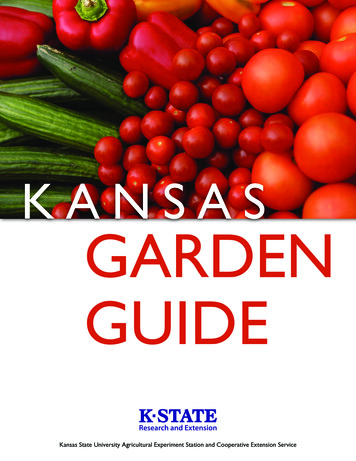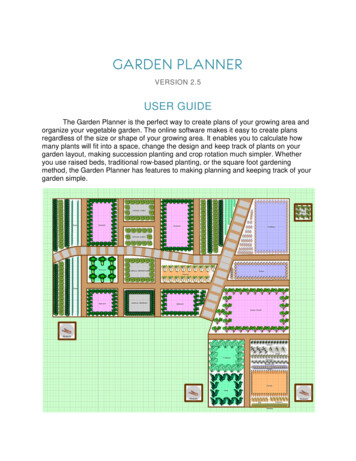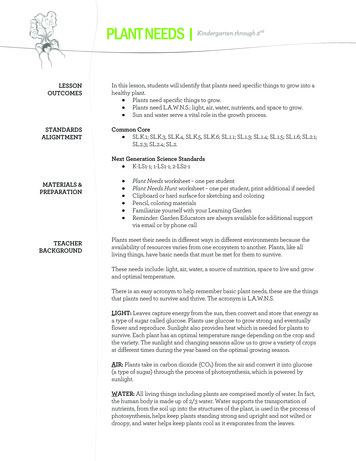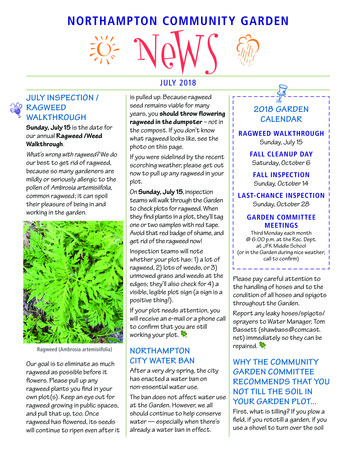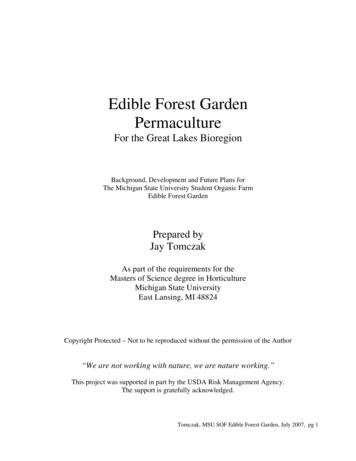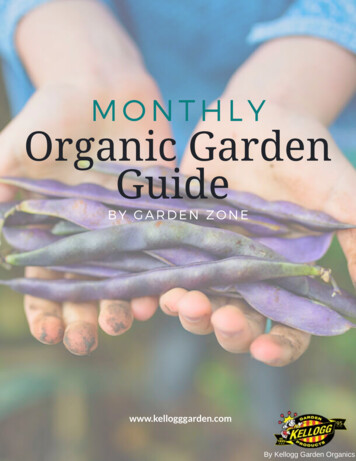
Transcription
MONTHLYOrganic GardenGuideBY GARDEN ZONEwww.kellogggarden.comBy Kellogg Garden Organics
ORGANIC BUILDS LIFETable of ContentsAuthor: Kellogg Garden Organics Garden: January Garden Planning Prepping & Maintaining Planting & Harvesting By Garden Zone Garden Checklist Garden: February 44567Garden Checklist 789Garden: March 10Garden Planning Prepping & Maintaining Planting & Harvesting By Garden Zone Garden Planning Prepping & Maintaining Planting & Harvesting By Garden Zone Garden Checklist Garden: April Garden Planning Prepping & Maintaining Planting & Harvesting By Garden Zone Garden Checklist Garden: May Garden Planning Prepping & Maintaining Planting & Harvesting By Garden Zone Garden Checklist Garden: June Garden Planning Prepping & Maintaining Planting & Harvesting By Garden Zone Garden Checklist 2Page 2 / 41
ORGANIC BUILDS LIFETable of Contents Garden: July Garden Planning Prepping & Maintaining Planting & Harvesting By Garden Zone Garden Checklist Garden: August 2323242526Garden Planning Prepping & Maintaining 26Planting & Harvesting By Garden Zone 2728Garden Checklist Garden: September 29Garden Checklist 293031Garden: October 32Garden Planning Prepping & Maintaining Planting & Harvesting By Garden Zone Garden Planning Prepping & Maintainingt Planting & Harvesting By Garden Zone Garden Checklist Garden: November Garden Planning Prepping & Maintaining Planting & Harvesting By Garden Zone Garden Checklist Garden: December Garden Planning Prepping & Maintaining Planting & Harvesting By Garden Zone Garden Checklist www.kellogggarden.com3233343535363738383940Page 3 / 41
MONTHLY ORGANIC GARDENING GUIDE BY GARDEN ZONEGarden: JanuaryHaving a garden is like having a good and loyal friend. Lucy DouglasAlthough the pace is slower and the demands are fewer, January is a pivotal month forplanning and preparing for the garden to come. It’s full of possibilities, and isn’t that themost exciting part of gardening?Plan – January is seed catalog month! Pour over new catalogs that arrive in the mail, make a listof new seeds, and place your order. Inventory your existing seeds, and compost any that are tooold to sow. Make a master plan of your garden. Plan for your new garden spaces. Observe thechanging light patterns that winter brings. Top 3 Raised Garden Bed Designs Organic Gardening Raised Bed Materials Container Gardening Tips Tricks and IdeasPrepare/Maintain – Take stock of all your garden tools — make necessary repairs, sharpenblades, and oil moving parts. Clean and organize your seed starting supplies, and be sure youhave enough seed-starter mix on hand for when your seeds arrive. Use a lightweight row coverto protects crops, and be at the ready to cover tender garden plants in case of freeze.www.kellogggarden.comPage 4 / 41
MONTHLY ORGANIC GARDENING GUIDE BY GARDEN ZONESOW & PLANT OUTDOORSSOW & PLANT INDOORSWhile colder zones may not be able to actively plantoutdoors during January, milder climates still havethe go-ahead.All zones can enjoy indoor houseplant gardening byplanting microgreens on their kitchen counter topto enjoy in winter salads.Zones 7-10 can plant asparagus crowns andstrawberry transplants, and set out transplantsof broccoli, cabbage, spinach, lettuce, dill, parsley,cilantro, and chervil. Direct sow seeds of arugula,beets, bok choy, carrots, fennel, radishes, turnips,and peas.Zones 5-6 may start seeds of cauliflower, cabbage,leeks, and onions. Zone 6 can start seeds ofpansies, snapdragons, dusty miller, begonias, anddelphiniums.Zones 9-10 can purchase seed potatoes andsprout them for spring planting.Zones 7-8 can start cauliflower, cabbage, kale,onions, broccoli, and lettuce seeds.preZones 9-10 can start seeds for everything Zones7-8 can, as well as spinach, broccoli, peas, beets, andcarrots.HARVEST BY ZONEZones 4-6 can dig parsnips left in the ground over winter.Zones 7-10 can harvest loads of greens and veggies including broccoli, arugula, cabbage, Brusselssprouts, cauliflower, collards, fennel, spinach, Swiss chard, radishes, leeks, kale, green onions, andmustard.www.kellogggarden.comPage 5 / 41
Book title:OBSERVATIONS:MONTHLY ORGANIC GARDENING GUIDE BY GARDEN ZONEJANAUARY GARDEN CHECKLISTPlan:Prepare & Maintain:Plant:Harvest:SQUARE FOOT PLANwww.kellogggarden.comPage 6 / 41
MONTHLY ORGANIC GARDENING GUIDE BY GARDEN ZONEGarden: FebruaryA garden is a grand teacher. It teaches patience and careful watchfulness; it teaches industry and thrift; above allit teaches entire trust. Gertrude JekyllNo matter where you might live, February is still winter. In milder climates, things startto warm up in March while other climates take until April or even May, but in February,most gardeners are still tapping their fingers. But we know this is not time to be wasted— good gardens start with good planning, and February gives you lots of time to do that. So let’sroll up our sleeves and get at it!Plan – Continue plans for this year’s garden — new plants to try, seeds to sow, and tools to trial.Speaking garden plans, February is a great month to look at your soil What Your Weeds Tell You About Your Garden SoilThe Importance of Garden Worms7 Reasons to Use Worm Poop in Your GardenPrepare/Maintain – Remember to monitor the weather and water in your plants thoroughlybefore a hard freeze. Ensure your plants have an adequate layer of mulch to protect them. Prune,feed, and mulch your roses. Prune fruit trees and spray for any noticeable pest or disease issues.Clean up birdhouses before they’re in demand again.www.kellogggarden.comPage 7 / 41
MONTHLY ORGANIC GARDENING GUIDE BY GARDEN ZONESOW & PLANT OUTDOORSSOW & PLANT INDOORSZones 7-8 can plant lettuce, cabbage, and onions.Seeds of radish, lettuce, beets, turnips, andspinach can be directly sown outdoors. Rememberto stagger your plantings with new plants every twoweeks to prolong your harvest! Any seeds startedindoors can be transplanted outside. Plant potatoesin trenches.Zones 5-6 can start seeds of broccoli, cabbage,beets, cauliflower, kale, lettuce, onions, leeks, andspinach.Zones 7-8 can start eggplant, peppers, and tomatoseeds.Zone 10 can begin planting corn, cucumbers,melons, squash, beans, peppers, and tomatoes —just be prepared to cover them in the event of a latefrost.HARVEST BY ZONEColder climates won’t be harvesting this month.Zones 7-10 can continue to harvest a wide range of veggies including arugula, beets, leeks, parsnips,chard, carrots, chives, fennel, chervil, kale, lettuce, onions, spinach, and sorrel.www.kellogggarden.comPage 8 / 41
Book title:OBSERVATIONS:MONTHLY ORGANIC GARDENING GUIDE BY GARDEN ZONEFEBRUARY GARDEN CHECKLISTPlan:Prepare & Maintain:Plant:Harvest:GARDEN TIP:The health of any individual plant or garden as a whole is only as good as the soilit’s planted in, so for us, it all starts with good soil. “That’s great,” you might say,“but how do I know if my soil is healthy?” Well, lots of different ways, but onetried-and-true method is the soil test.www.kellogggarden.comPage 9 / 41
MONTHLY ORGANIC GARDENING GUIDE BY GARDEN ZONEGarden: MarchA weed is a plant that has mastered every survival skill except for learning how to grow in rows. Doug LarsonGarden die-hards are happy when March rolls around, especially in the more mildclimates. Trees are budding out, birds are chirping, and everywhere around there aresigns of new life. Little wonder that Spring is the favorite season of so many people.And those of you in colder climates — we haven’t forgotten about you! We realize it’s not yourhigh garden month, but you can console yourself with the fact that your time is drawing near.Plan – March can be a month with unpredictable weather — remember to record significantweather events in your garden journal. Make a list of new plants to include this year for our pollinator friends — milkweed for monarchs, dill and fennel for swallowtails, and rosemary, basil, parsley, cilantro, and dill blooms for bees.Prepare/Maintain – Begin monitoring plants for pest and disease issues. Control weeds,particularly in areas where the weather is warming up. Refresh mulch as necessary, and add soilamendments and compost if needed.Spring Lawn Care - Aerate. Aerationis a process by which small plugs of soil areremoved so that air, water, and nutrientsget where they need to go. Over time andwith lots of traffic, soil becomes hard andcompressed, and thatch builds up. Aerationaddresses this problem.The best time to aerate is in thespring as things start heating up— aerate cool season grasses likeKentucky bluegrass and tall fescue inearly Spring, and warm season grasseslike Bermuda grass and St. Augustine inlate Spring.www.kellogggarden.comPage 10 / 41
ORGANIC BUILDS LIFESOW & PLANT INDOORSZONE 3If you have flowering shrubs, go ahead and prune them unless they are springflowering. Water any shrubs you have near the foundation of your house if the soilthere is dry. Bring out your stored bulbs (tuberous begonias, calla lilies, dahlias,cannas) and place them near a light source. Start seeds of cabbage, cauliflower,marigolds, onions, tomatoes, Brussels sprouts, and asters indoors under grow lights.ZONES 6-8Start seeds for beets, cabbage, carrots, kale, lettuce, onions, peppers, spinach,tomatoes and beans.ZONES 9-10Start seeds for Brussels sprouts, okra, watermelons and squash.www.kellogggarden.comPage 11 / 41
ORGANIC BUILDS LIFESOW & PLANT OUTDOORSZONE 6This is a perfect month to plant roses, trees, and shrubs if you’reenjoying mild weather. Move cauliflower and broccoli transplantsoutdoors to a cold frame.ZONES 7-8Begin planting beets, broccoli, cabbage, carrots, cauliflower, kale,spinach, turnips and corn. Heat-loving Swiss chard can also goin at the middle of the month. Plant daisies, marigolds, petunias,and snapdragons for early season color. Got any cool seasoncrops left to plant? Get them into the garden now — if youdawdle, the heat will do them in.ZONES 9-10Continue to plant all the same plants as Zone 8 with theaddition of beans, cucumbers, okra, sweet potatoes, eggplant,squash, tomatoes and peppers. If you started seeds of peppers,tomatoes, and eggplants last month, harden them off by movingthem outside. Be prepared to cover them or put them insidea cold frame, and plant them in the garden when all danger offrost has passed. Add compost to the soil around establishedtrees and shrubs, as well as around new plants.HARVEST BY ZONEZONES 9-10 Continue to harvest broccoli, Brussels sprouts, cabbage, onions,Set out yourfavorite herbsinto the garden, butwait a bit longer toplant basil.Fertilize your lawnat the end of themonth.Take a look atyour citrustrees, and carefullyprune off any frostdamaged parts.This is plantingmonth for youlucky gardeners!radish, turnips, lettuce, peas, and spinach as they become ready.www.kellogggarden.comPage 12 / 41
Book title:OBSERVATIONS:MONTHLY ORGANIC GARDENING GUIDE BY GARDEN ZONEMARCH GARDEN CHECKLISTPlan:Prepare & ggarden.comPage 13 / 41
MONTHLY ORGANIC GARDENING GUIDE BY GARDEN ZONEGarden: AprilSpring is finally here! Even though you might live in an area that’s still a bit chilly, there’sno doubt that the garden is answering its annual wake-up call. Many gardeners call thistheir favorite season of the year — it’s thrilling to see little seedlings emerging, greenleaves pushing their way out, and the first signs of color. This is often a very busy month, so let’sorganize our garden goals to keep on track.Plan – Even though April is a big action month, successful gardens are always in the planningstage. As your garden is waking up, so are the insects that inhabit it. Plan to take a daily tourof your garden to be on the lookout for pesky creatures, and be prepared to take action ifnecessary. Pill bugs, slugs, and snails cause lots of problems, so have your traps and baits at theready. Continue to update your garden journal with observations, weather notes, and plantingtimes.Prepare/Maintain – If you planted winter cover crops, cut them down and turn them intothe soil two weeks before planting. Turn your compost pile, start a new one, and add compostaround your plants. Fertilize veggies with an organic foliar feed to keep them healthy.Pests – Be on the lookout for garden pests and diseases. Aphids, beetles, thrips, and cutwormscan do quite a bit of damage seemingly overnight at this time of the year. It’s good to do a gardeninspection every couple of days to identify any possible problems. Remember to look underleaves, along stems, at the base of the plant, and where new growth is emerging — these are allfavorite hiding places for damaging insects.www.kellogggarden.comPage 14 / 41
MONTHLY ORGANIC GARDENING GUIDE BY GARDEN ZONESOW & PLANT OUTDOORSHARVESTZones 5-6 can transplant tomatoes outside, butbe prepared to cover them in the event of a coldsnap. Sow lettuce, carrots, spinach, radishes, beets,and turnips. Repeat plantings every two weeks toensure a continual harvest.Zone 4 can harvest beets, collards, kale, spinach,and lettuce.Zones 7-8 can plant cantaloupe, cucumber,eggplant, okra, peppers, squash and tomatoes if youhaven’t already.Zones 7-10 can harvest squash, beets, broccoli,carrots, eggplant, greens, onions, peas, radishes,and turnips as they become ready.Zones 5-6 can enjoy arugula, spinach, radishes,lettuce, carrots, and kohlrabi.Zones 9-10 can plant everything in Zones 7-8as well as directly sowing pumpkins and sweetpotatoes.SOW & PLANT INDOORSBecause spring is here, much of our indoor seeding is complete.However, if you live in chilly Zone 4 & 5 you can start seeds for tomatoes, broccoli, beets, Brusselssprouts, sweet potatoes, peppers, peas, and carrots.www.kellogggarden.comPage 15 / 41
Book title:OBSERVATIONS:MONTHLY ORGANIC GARDENING GUIDE BY GARDEN ZONEAPRIL GARDEN CHECKLISTPlan:Prepare & Maintain:Plant:Harvest:PEST PATROLwww.kellogggarden.comPage 16 / 41
MONTHLY ORGANIC GARDENING GUIDE BY GARDEN ZONEGarden: MayI am a Gardener. What’s Your Super Power?It’s safe to say that even for the northernmost planting zones, spring is here! May is a busymonth in the garden, and it’s also a thrilling one. Morning strolls through the garden revealnew seedlings popping up, flowers unfolding, and some veggies ripening. While it’s temptingto plant everything at the first sign of a warm day, May has a tendency to bring unexpectedweather that can damage your garden. Late cold snaps, heavy rains, and strong winds are all stillpossible, so be prepared to protect your garden from inclement weather.Plan – If you kept up with your late winter/early spring chores and planning, May should be alittle easier. Still, it’s worth noting in your garden journal any successes you’ve experienced withyour plantings. Is there something that you might have planted sooner (or later) than you did?What pests are you observing in the garden so far? How much rain are you getting?Prepare/Maintain – Keep up with your weedingchores — May can be a doozy! Reapply mulch if yousee any bare spots on the soil surface. Be sure yourirrigation system continues to operate efficiently asthe growing season heats up. If you live in an areawith watering restrictions or guidelines, make sureyour watering schedule honors that. Feed fruittrees, and thin fruit to every 6” while the fruit isstill small.Pollinators – Make sure you plant for themonarchs. While they drink nectar froma variety of flowers, Monarch butterfliesonly eat milkweed, so it’s vital to plant a widerange of native nectar plants as well as nativemilkweed (Asclepias spp.).www.kellogggarden.comPage 17 / 41
MONTHLY ORGANIC GARDENING GUIDE BY GARDEN ZONESOW & PLANT OUTDOORSZones 3-4 can plant transplants of beans, tomatoes, peas, kale, melons, potatoes, and pumpkin.They can directly sow seeds of kale and lettuce. When soil temperatures reach 60 degrees, Zone 4gardeners can begin planting peppers and eggplant transplants.Zones 5-6 can direct sow seeds of squash, lettuce, melons, cucumber, corn, and tomatoes.Zones 7-8 can transplant beans, Brussels sprouts, corn, cabbage, peppers, cucumber, and squash.Zones 9-10 can transplant Brussels sprouts, melons, okra, and squash if you haven’t already.SOW & PLANT INDOORSZones 3-4 may start seeds of Brussels sprouts,kale, lettuce, pears, peppers, and spinachunder grow lights.Zones 5-7 can start seeds of beans, corn,pumpkin, cucmber, onion, and squash.All other zones continue with outdoor plantingand sowing.www.kellogggarden.comHARVESTZones 6-7 can harvest peas, beets, carrots,broccoli, cauliflower, kale, spinach, and lettuce.Zone 8 can harvest beets, carrots, broccoli,cauliflower, kale, lettuce, peas, and spinach.Zones 9-10 can harvest beans, garlic, cabbage,carrots, cauliflower, corn, cucumber, onions,potatoes, radish, squash, peppers, andtomatoes.Page 18 / 41
Book title:OBSERVATIONS:MONTHLY ORGANIC GARDENING GUIDE BY GARDEN ZONEMAY GARDEN CHECKLISTPlan:Prepare & Maintain:Plant:Harvest:FALL GARDEN PLANwww.kellogggarden.comPage 19 / 41
MONTHLY ORGANIC GARDENING GUIDE BY GARDEN ZONEGarden: JuneI like gardening - it’s a place where I find myself when I need to lose myself. Alice SeboldJune 21 is the official first day of summer, but for many gardeners, it’s full-on heat already!By now, you’ve likely planted much of your warm season garden, but planting and gardenchores continue this month in spite of the heat or humidity. Follow this checklist to staycurrent with your June garden chores, always remembering to consult your local garden expertson the best times to plant.Plan – Remember last year when you had so many zucchini, tomatoes, and figs that you didn’tknow what to do with them? Make a plan now for creative ways to use your surplus harvest so itdoesn’t go to waste. How to Safely Preserve Your Organic Harvest Fun Foods to FermentHave a watering plan in place to ensure your garden gets adequate irrigation when rainfall levelsare low and temps are high.Prepare/Maintain – From planting, watering, weeding, and even harvesting, June keeps agardener busy. It’s good to set goals for your garden.Provide support structures or cages for peas, cucumbers, beans, or tomatoes. Be on thelookout for garden pests like stinkbugs, grasshoppers, snails/slugs, and caterpillars — they cando enormous damage overnight. Make sure all planted beds (both edible and ornamental) areadequately mulched to suppress weeds and preserve soil moisture.www.kellogggarden.comPage 20 / 41
MONTHLY ORGANIC GARDENING GUIDE BY GARDEN ZONESOW & PLANT OUTDOORSZone 4: Harden off tomato, pepper, and eggplant transplants and get them out into the garden. Goahead and directly sow seeds of squash, sweet potatoes, rutabagas, okra, cucumbers, beets, corn,leaf lettuce, and lima beans into the garden as well. Plant container roses, shrubs, trees, as well aswarm-season annuals and heat-loving herbs.Zones 5-6: Direct sow seeds of bush beans, pole beans, cucumbers, squash, and melons. You can alsodirect sow kale, salad greens (only heat-tolerant varieties), carrots, beets, and radishes. Get tomatoes, eggplant, and peppers in the ground, too, as well as warm season annuals.Zones 7-8: Continue succession planting pole beans, bush beans, winter squash, okra, black-eyedpeas, and Malabar spinach. Most herbs can still be planted, as well as warm season annuals. If you’replanting perennials, be sure to give them plenty of regular water to get established, and avoid planting during heat waves when your plants can get stressed.Pests – From planting, watering, weeding, and even harvesting, June keeps a gardenerbusy. The only problem is, the bugs and pests are also busy — they love a thriving garden asmuch as you do! Luckily there are natural ways to get rid of destructive pests and insects.As always, cultivating strong and healthy plants goes a long way to deterring unwanted anddamaging garden pests — start with healthy soil and ensure adequate sunlight and water.Next purchasing and attracting the good bugs for organic pest control will also help youwin the bug battle.SOW & PLANT INDOORSZones 7-10: Get ready for fall gardening bystarting seeds of tomatoes, peppers, andeggplant.HARVESTZones 4-6: Harvest beets, turnips, kale,lettuce, cauliflower, broccoli, and asparagus.Zones 7-10: Harvest beets, squash, Malabarspinach, corn, beans, cucumbers, tomatoes,peppers, potatoes, and eggplant.www.kellogggarden.comPage 21 / 41
Book title:OBSERVATIONS:MONTHLY ORGANIC GARDENING GUIDE BY GARDEN ZONEJUNE GARDEN CHECKLISTPlan:Prepare & Maintain:Plant:Harvest:DON'T FORGET:Make notes about fruits and veggies that are super tasty, as well as theannuals that are thriving or bugs that are munching. You only thinkyou’ll remember, and we don’t want you kicking yourself later.www.kellogggarden.comPage 22 / 41
MONTHLY ORGANIC GARDENING GUIDE BY GARDEN ZONEGarden: JulyWhile June temps can still be on the cooler side in some of the milder climates,July is the great equalizer. No matter where you live, July’s strong sun and hightemperatures make gardening a bit of a challenge for both the garden and thegardener alike. But no worries — we’ve got a July garden checklist to keep you cool and on track!Plan – Remember the garden journal we talked about? Now’s the time to use it — record whatyou planted and where, how things are growing, and any unusual pests, diseases, or weather issues that you notice. Take photos to keep the details fresh, and jot down notes for the fall garden.Prepare/Maintain – Continue to stay on top of weeds so they don’t take over your veggies orflowers. Water deeply but less frequently to avoid stressing your plants, and water earlier in themorning to give everything a better chance to withstand the afternoon heat. Summer Lawn Watering Tips Shading Plants From Summer HeatGet your container plantings and annual flowers on a regular fertilizing schedule using organicmaterials. Remove and dispose of any dead or diseased plants, mulch or use cover crops toprotect soil surfaces, and collect seeds from plants that are doing well. You’ll be happy next yearthat you did!www.kellogggarden.comPage 23 / 41
MONTHLY ORGANIC GARDENING GUIDE BY GARDEN ZONESOW & PLANT OUTDOORSSOW & PLANT INDOORSMost zones can plant almost anything right now,from veggies and fruits to perennials and annuals.If you live in areas of high heat, avoid planting treesand large shrubs during this time, however — thesoaring temps will stress them too much while theyare getting established.While most of our garden activity focusesoutdoors, there are still indoor garden chores to do,particularly if you are planning ahead for your fallgarden.Zone 4 can set out transplants of broccoli,cauliflower, and cabbage as well as a second crop ofgreen beans and summer squash. Seeds of kale andAsian greens can be sown for fall harvest.Zones 5-6 can plant cilantro, bush beans, andsummer squash, as well as carrots, kale, beets, andchard for fall harvest.Zones 4-6 may pre-sprout peas (snow and sugarsnap) and start seeds for broccoli, carrots, spinach,lettuce, kale, and beets.Zone 7 can start seeds for cabbage.Zones 9-10: can start seeds for peppers, Brusselssprouts, cabbage, and tomatoes for the fall season.Zones 7-8 can start more tomatoes, peppers,and eggplant for late summer harvest, and beans,squash, turnips, beets, carrots, and lettuce for thefall.HARVEST BY ZONEZones 4-5: Continue to harvest lettuce, spinach, beets, and carrots when they are ready.Zones 6-7: Harvest lettuce, onions, cabbage, and tomatoes at the end of the month.Zones 8-10: Harvest squash, cucumbers, melons, and tomatoes at the end of the month.www.kellogggarden.comPage 24 / 41
Book title:OBSERVATIONS:MONTHLY ORGANIC GARDENING GUIDE BY GARDEN ZONEJULY GARDEN CHECKLISTPlan:Prepare & Maintain:Plant:Harvest:PLANT PROTECTION: HEAT, WATER, DISEASEwww.kellogggarden.comPage 25 / 41
MONTHLY ORGANIC GARDENING GUIDE BY GARDEN ZONEGarden: AugustThe love of gardening is a seed once sown that never dies Gertrude JekyllCome August, many gardens and gardeners are just bone weary. The summer heat hastaken its toll, and in some of the warmer climates, August is the hottest month of theyear. To combat the late summer blues, stay strong and start planning for your fall garden— just the thought of cooler weather is often enough to help me hang in there.Plan – continue updating your garden journal, making notes about heat, temperatures, humidity, and rainfall. Have shadecloth on hand to give your summer veggies a bit of a break from thestrong sun — my peppers, in particular, appreciate this gesture. Begin planning for your fall garden— what to plant, and where and when to plant it. Order your garlic for fall planting.Prepare/Maintain – Remove flowers on pumpkin vines and tomato plants to direct the plant’senergy into growing the existing fruit.Prune tomatoes, peppers, and eggplant to encourage new growth. Your peppers, tomatoes,squash, and eggplant may even appreciate a bit of fertilizer to catch their second wind. Cut basilback to keep it from going to seed.Remove dead or dying plants — it’s notworth the extra effort to keep them alivethis late in the summer. Cooler climatesshould watch the forecast for early frosts— be prepared to protect plants fromdamage.Warmer climates can continue plantingand harvesting. All climates can save seedsfrom the best and healthiest plants in thegarden.www.kellogggarden.comPage 26 / 41
MONTHLY ORGANIC GARDENING GUIDE BY GARDEN ZONESOW & PLANT INDOORSZone 6 can start carrots, kale, lettuce, andpeas.SOW & PLANT OUTDOORSZone 4 can plant any remaining beets,broccoli and carrots as well as fast-growingcool weather lettuces and spinach in coldframes.HARVESTZones 4-5 can harvest lettuce, spinach,squash, carrots, cucumbers, and beans.Zones 6-7 can harvest Brussels sprouts,celery, tomatoes, squash, potatoes,cucumbers, corn, and beans.Zones 8-10 can harvest celery, sweetpotatoes, potatoes, tomatoes, eggplants,peppers, corn, and beans.Zones 5-6 can plant any remaining beans,beets, broccoli, cabbage, Brussels sprouts,carrots, and spinach.Zones 7-8 can sow seeds of corn, cucumbers,squash, and dill in the garden. Set outtransplants of tomatoes, peppers, basil, andeggplant for fall harvest. Transplant anyindoor seedlings of broccoli, cauliflower,collards, chard, and cabbage into the garden,but be prepared to cover them with shadecloth if temps get above 90 degrees.www.kellogggarden.comLAWNS & LANDSCAPESZones 9-11 remove dead, damaged, ordiseased wood on trees as soon as youobserve it, but save major pruning for thedormant season. Raise the height of yourmower blade to 1” – 1 ½” to help your lawnthrive in the late summer heat.Page 27 / 41
Book title:OBSERVATIONS:MONTHLY ORGANIC GARDENING GUIDE BY GARDEN ZONEAUGUST GARDEN CHECKLISTPlan:Prepare & Maintain:Plant:Harvest:FALL GARDEN PLANwww.kellogggarden.comPage 28 / 41
MONTHLY ORGANIC GARDENING GUIDE BY GARDEN ZONEGarden: SeptemberThere are no gardening mistakes, only experiments. Janet Kilburn PhillipsAh, September! The kids are back to school, the mornings are getting crisper, and there’sa sense of fall in the air. For those living in warmer climates, that sense of fall mightjust be in your head, but we’ll take what we can get, right? There’s something about thepromise of this change of season that is both relaxing and exciting — but let’s not get ahead ofourselves, because there’s still plenty to do if you follow our September Garden Checklist!Plan – With summer’s end in sight, be sure to complete all your notes about your summer garden in your journal. What new plant surprised you? What would you plant more of next year?Any do-overs on your list? How was the weather, and how did it impact your garden?Prepare/Maintain – No matter your zone, September is a prep month for almost everygardener.Harvest your vegetable garden before danger of frost or freeze, or to make room for your fallplantings. Put spent leaves and plants (veggies, perennial clippings, annual flowers) into yourcompost pile. Gather herbs for drying or freezing, and collect valuable seeds for next year. Usewinter rye as a cover crop in colder climates.Warmer Zones 7-10 will need to continue shading your soil until the temperatures start to dropin earnest.Fall Lawn Care Tip – Sow grass seed. Got thinspots in your lawn? Now’s the time to fill ‘em in.Scratch the soil with a hard rake, scatter your grassseed, and cover with a light layer of compost or highquality garden soil. Water frequently until grass seedgerminates. Fertilizing Your Fall Lawn In 6 Steps Prepare Your Winter Lawn In 5 Stepswww.kellogggarden.comPage 29 / 41
MONTHLY ORGANIC GARDENING GUIDE BY GARDEN ZONESOW & PLANT OUTDOORSSOW & PLANT INDOORSZones 4-6 can plant garlic and shallots, as well asspinach either under row covers or in cold frames.Zones 7-10 can plant greens, beets, turnips,radishes, lettuce, broccoli, cauliflower, kale, and bokchoy.Zones 7-10 can still plant outdoors, but it’s also funto get a head start on anything you’d like to plantfor the cooler months. Start seeds of cool seasonannuals, greens, broccoli, cauliflower, carrots, beets,and radishes.Zone 10 still has time for a last round of squash,cucumbers, and okra, final plantings of tomatoesand peppers, and cool season greens.HARVEST BY ZONEZone 4 can harvest turnips, parsnips, apples, carrots, greens, beets, pears, and persimmons.Zones 5-10 can harvest pretty much everything from basil, beans, beets, cucumbers, and eggplant togreens, peppers, squash, tomatoes, and sweet potatoes.www.kellogggarden.comPage 30 / 41
Book title:OBSERVATIONS:MONTHLY ORGANIC GARDENING GUIDE BY GARDEN ZONESEPTEMBER GARDEN CHECKLISTPlan:Prepare & Maintain:Plant:Harvest:GARDEN CLEAN UP:www.kellogggarden.comPage 31 / 41
MONTHLY ORGANIC GARDENING GUIDE BY GARDEN ZONEGarden: OctoberThe glory of gardening: hands in the dirt, head in the sun, heart with nature. Alfred AustinIt’s Octobe
Plan – Continue plans for this year’s garden — new plants to try, seeds to sow, and tools to trial. Speaking garden plans, February is a great month to look at your soil . A weed is a plant that has mastered every survival skill except for learning how to grow i


